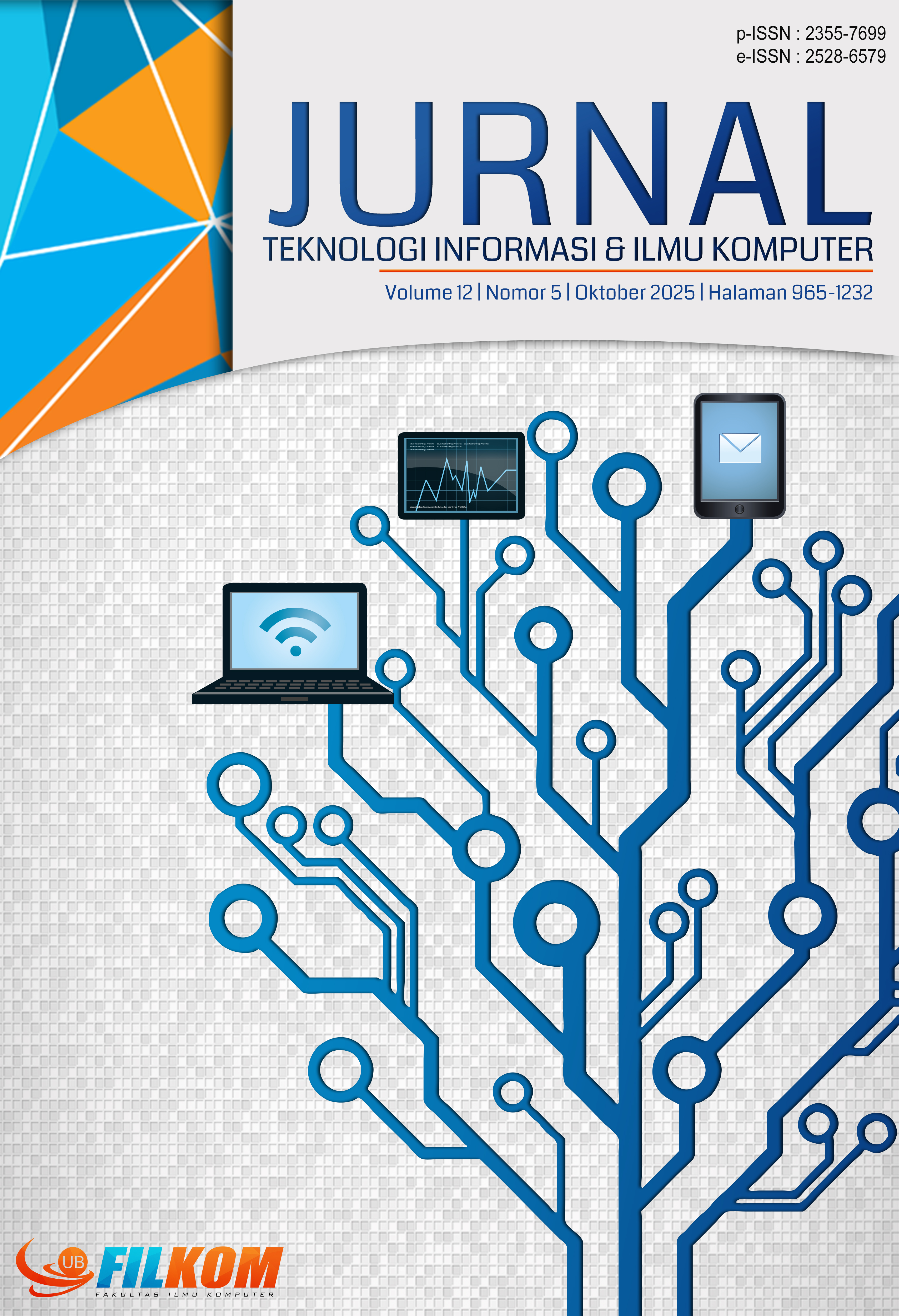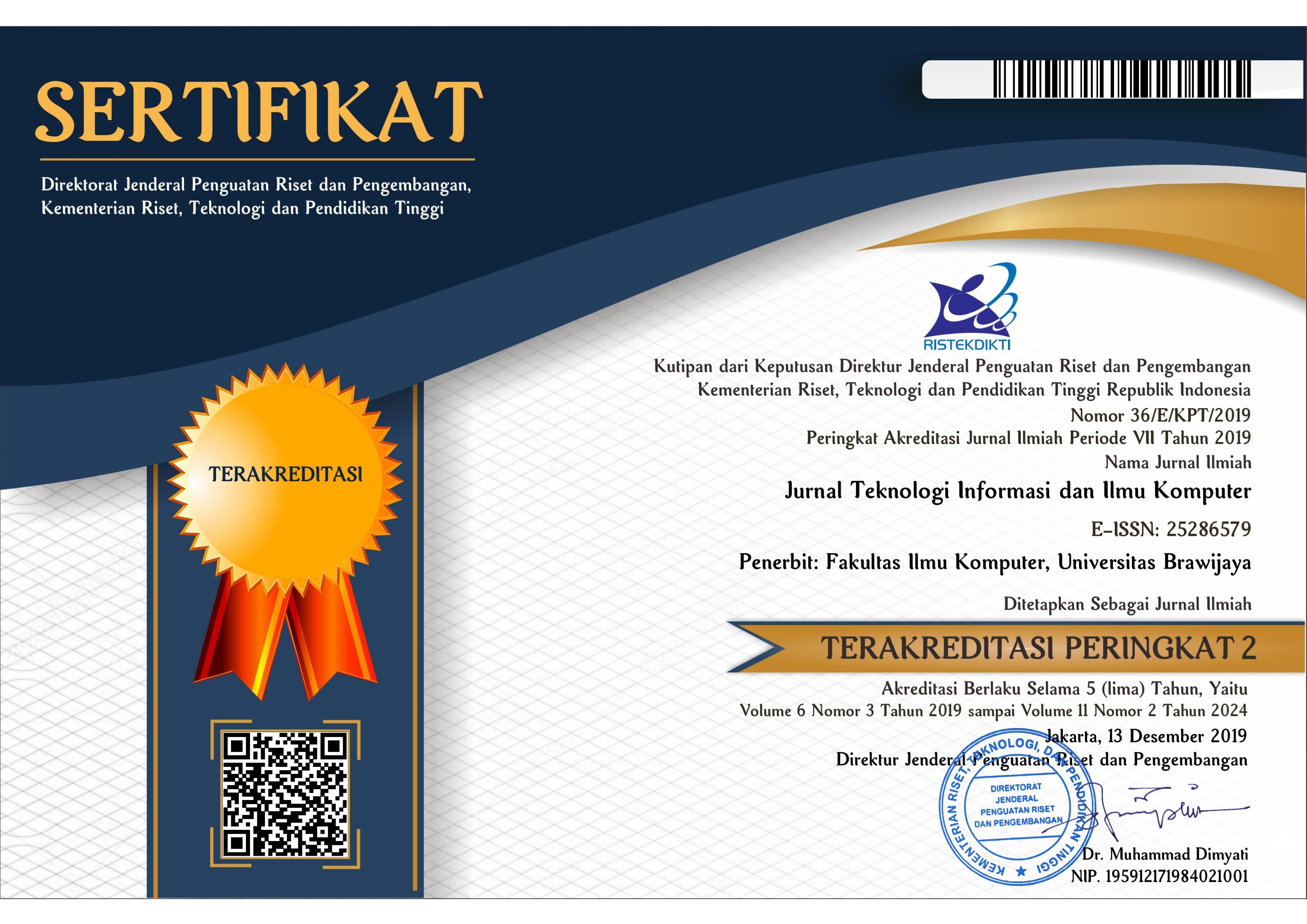Seabank Apps: Niat Penggunaan Berkelanjutan Berdasarkan Extended Expectation Confirmation Model dan Delone & Mclean Model
DOI:
https://doi.org/10.25126/jtiik.2025125Kata Kunci:
SeaBank, Expectation Confirmation Model, dan DeLone & McLean IS Success ModelAbstrak
SeaBank Apps, sebagai aplikasi layanan perbankan digital yang cukup populer di Indonesia, masih menghadapi sejumlah tantangan yang ditandai dengan berbagai keluhan dari pengguna, seperti masalah keamanan, keandalan, dan kualitas layanan aplikasi (Suara Konsumen, 2024). Hal tersebut mendasari pentingnya memahami lebih dalam faktor-faktor yang dapat mempertahankan pengguna dalam konteks persaingan aplikasi keuangan digital yang semakin ketat. Penelitian ini bertujuan untuk mengeksplorasi niat penggunaan berkelanjutan aplikasi SeaBank berdasarkan extended Expectation Confirmation Model (ECM) dan DeLone & McLean Model. Metode yang digunakan survei kuantitatif dengan mengumpulkan data sebanyak 115 responden sebagai pengguna SeaBank. Data yang telah terkumpul dianalisis menggunakan teknik analisis data SmartPLS untuk menguji hubungan antar variabel yang dihipotesiskan. Hipotesis yang dikembangkan dalam penelitian ini sebanyak 13 hipotesis, dimana terdapat tiga hipotesis yang ditolak yaitu information quality dan service quality tidak berpengaruh terhadap satisfaction serta satisfaction tidak memediasi antara information quality terhadap continuance use intention. Variabel expectation confirmation menjadi faktor terbesar yang mempengaruhi satisfaction dan continuance use intention. Temuan ini bahwa pengelola aplikasi SeaBank perlu fokus pada peningkatan konfirmasi harapan dan kegunaan yang dirasakan untuk meningkatkan kepuasan dan niat penggunaan keberlanjutan. Penelitian ini memberikan wawasan penting bagi pengembang aplikasi dan manajer dalam merancang strategi yang efektif untuk mempertahankan pengguna. Informasi yang dihasilkan dari penelitian ini diharapkan dapat membantu pengambil keputusan dalam merancang strategi yang lebih efektif untuk meningkatkan user engagement dan retensi pengguna aplikasi perbankan digital.
Abstract
SeaBank Apps, as a relatively popular digital banking service application in Indonesia, still faces several challenges marked by various user complaints, such as issues related to security, reliability, and service quality of the application (Suara Konsumen, 2024). This underlines the importance of gaining a deeper understanding of the factors that can retain users in the increasingly competitive context of digital financial applications. This study aims to explore the continuance intention to use the SeaBank application based on the extended Expectation Confirmation Model (ECM) and the DeLone & McLean Model. The method used is a quantitative survey, collecting data from 115 respondents who are SeaBank users. The collected data were analyzed using SmartPLS data analysis techniques to test the hypothesized relationships between variables. The hypotheses developed in this study number 13, of which three hypotheses were rejected: information quality and service quality do not affect satisfaction, and satisfaction does not mediate the relationship between information quality and continuance use intention. The expectation confirmation variable is the largest factor influencing satisfaction and continuance use intention. The conclusion from these findings is that SeaBank application managers need to focus on improving expectation confirmation and perceived usefulness to enhance satisfaction and continuance use intention. This research provides valuable insights for application developers and managers in designing effective strategies to retain users. The information generated from this study is expected to assist decision-makers in crafting more effective strategies to increase user engagement and retention of digital banking applications.
Downloads
Referensi
AKIN, M. AND YETGIN, M.A., 2025. The Impact of the Customer Experience Offered to Customers Through Digital Banking Applications on Customer Loyalty and Customer Satisfaction. Financial Landscape Transformation: Technological Disruptions. [online] Emerald Publishing Limited. pp.51–65. https://doi.org/10.1108/978-1-83753-750-120251004.
ALGHANAYEM, H., 2023. A Dark Side of Retargeting? How Advertisements That Follow Users Affect Post-Purchase Consumer Behavior: Evidence From the Tourism Industry in Saudi Arabia. Innovative Marketing, 19(4), pp.234–246. https://doi.org/10.21511/im.19(4).2023.19.
ALMANSOUR, B.Y. AND ELKRGHLI, S., 2023. Factors Influencing Customer Satisfaction on E-Banking Services: A Study of Libyan Banks. International Journal of Technology Innovation and Management (Ijtim), 3(1), pp.34–42. https://doi.org/10.54489/ijtim.v3i1.211.
ALTURAS, B., 2023. Construction of Remote Patient Perceived Value Satisfaction Model With Online Medical Service for Specialties Based on ACSIM and TAM. https://doi.org/10.22541/au.169931041.11042262/v1.
APIDANA, Y., 2023. The Influence of E-Trust and E-Servqual on E-Repurchase Intention With E-Satisfaction as an Intervening Variable. Jurnal Ilmiah Manajemen Kesatuan, 11(3), pp.1075–1086. https://doi.org/10.37641/jimkes.v11i3.2241.
ARIANI, N.K.D., 2023. The Effect of Service Quality and Product Quality on Consumer Repurchase Intention With Satisfaction as a Mediating Variable at Putri Ayu’s Weaving in Gianyar Regency. Management and Applied Social Studies Review, 1(2), pp.64–70. https://doi.org/10.32795/massiv.v1i2.4280.
CHENG, Y.M., 2021. Investigating medical professionals’ continuance intention of the cloud-based e-learning system: an extension of expectation–confirmation model with flow theory. Journal of Enterprise Information Management, 34(4), pp.1169–1202. https://doi.org/10.1108/JEIM-12-2019-0401.
DARMIASIH, M. AND SETIAWAN, P.Y., 2020. Continuance usage intention and its antecedents on using OVO e-wallet application in Denpasar. International research journal of management, IT and social sciences, 8(1), pp.35–46. https://doi.org/10.21744/irjmis.v8n1.1104.
ERDOGAN, G., 2023. Examining the Determinants of the Customer’s Continuance Intention in Mobile Banking: Integrating ECM and D&M Model. Sosyal Bilimler Metinleri, 2023(2), pp.137–152. https://doi.org/10.56337/sbm.1350089.
GARG, S. AND SHARMA, S., 2020. User Satisfaction and Continuance Intention for Using E-Training: A Structural Equation Model. Vision the Journal of Business Perspective, 24(4), pp.441–451. https://doi.org/10.1177/0972262920926827.
GHAZI HAMEED AL-RIKABI, A., BIN SUMARI, P. AND A. YOUNIS, H., 2024. Continued Usage Intention of Mobile Learning (M-Learning) in Iraqi Universities Under an Unstable Environment: Integrating the ECM and UTAUT2 Models. Interdisciplinary Journal of Information, Knowledge, and Management, [online] 19, p.003. https://doi.org/10.28945/5250.
GUNAWAN, F.M., 2024. The Mediation Effect of Corporate Image and Customer Satisfaction, Towards Revisit Intention (Study on Starbucks Reserve Dewata, Bali). Journal of Economics Finance and Management Studies, 07(02). https://doi.org/10.47191/jefms/v7-i2-06.
HAIR., J.F., BLACK., W.C., BABIN, B.J. AND ANDERSON, R.E., 2019. Multivariate Data Analysis. Mathematics of Computation, https://doi.org/10.2307/2007941.
HARAHAP, E.F., ARIMBAWA, I.G.A.P., SUCANDRAWATI, N.L.K.A.S., NURDIANI, T.W. AND ANANTADJAYA, S.P., 2023. Digital bank transformation: A content analysis of SEABank. Jurnal Komunikasi Profesional, 7(3), pp.383–395. https://doi.org/10.25139/jkp.v7i3.6363.
HIDAYAT-UR-REHMAN, I., AKRAM, M.S., MALIK, A., MOKHTAR, S.A., BHATTI, Z.A. AND KHAN, M.A., 2020. Exploring the Determinants of Digital Content Adoption by Academics: The Moderating Role of Environmental Concerns and Price Value. Sage Open, 10(2), p.215824402093185. https://doi.org/10.1177/2158244020931856.
JATIMOYO, D., ROHMAN, F. AND DJAZULI, A., 2021. The Effect of Perceived Ease of Use on Continuance Intention Through Perceived Usefulness and Trust. International Journal of Research in Business and Social Science (2147-4478), 10(4), pp.430–437. https://doi.org/10.20525/ijrbs.v10i4.1223.
KALA, D., SHANKER CHAUBEY, D., KUMAR MEET, R. AND SAMED AL-ADWAN, A., 2024. Impact of User Satisfaction With E-Government Services on Continuance Use Intention and Citizen Trust Using TAM-ISSM Framework. Interdisciplinary Journal of Information, Knowledge, and Management, [online] 19(November), p.001. https://doi.org/10.28945/5248.
KARUNDENG, D.R., SUYANTO, M.A. AND MOKOAGOW, A., 2024. Influence of Quality, Procedures, and Service Facilities on Community Satisfaction with Hydrological Data Services at the Sulawesi II Gorontalo River Basin Center. International Journal of Multidisciplinary Approach Research and Science, 2(02), pp.540–549. https://doi.org/10.59653/ijmars.v2i02.625.
KRISTI, N., SHIDDIEQ, D.F. AND NURHAYATI, D., 2024. Analisis Penerimaan Aplikasi Flip Menggunakan Model Unified of Acceptance and Use of Technology 3. MALCOM: Indonesian Journal of Machine Learning and Computer Science, 4(2), pp.685–694. https://doi.org/10.57152/malcom.v4i2.1316.
LEE, L.K., FUNG, Y.C., PUN, Y.W., WONG, K.K., YU, M.T.Y. AND WU, N.I., 2020. Using a Multiplatform Chatbot as an Online Tutor in a University Course. Proceedings - 2020 International Symposium on Educational Technology, ISET 2020, pp.53–56. https://doi.org/10.1109/ISET49818.2020.00021.
LI, X. AND LIN, H.-H., 2022. Using the Extended Acceptance Model to Understand Continuance Intention of Dockless Bike-Sharing. Frontiers in Psychology, 13. https://doi.org/10.3389/fpsyg.2022.786693.
MAQABLEH, M., HMOUD, H.Y., JARADAT, M. AND MASA’DEH, R., 2021. Integrating an Information Systems Success Model With Perceived Privacy, Perceived Security, and Trust: The Moderating Role of Facebook Addiction. Heliyon, 7(9), p.e07899. https://doi.org/10.1016/j.heliyon.2021.e07899.
MASRANI, S.A., 2023. Important Factors in Measuring Learners’ Satisfaction and Continuance Intention in Open And distance Learning (ODL) Institutions. Higher Education Skills and Work-Based Learning, 13(3), pp.587–608. https://doi.org/10.1108/heswbl-12-2022-0274.
MASUNGA, F.J., MAPESA, H.J., MWAKIBETE, A.N., DEREFA, M.J., MYAVA, J.E. AND KIRIA, J.S., 2021. The Role of Mediating Effects of User Satisfaction and Behavioural Intention on the Influence of the E-Tax System on Tax Compliance Behaviour: An Application of Bootstrapping Technique. Tijab (The International Journal of Applied Business), 5(2), p.137. https://doi.org/10.20473/tijab.v5.i2.2021.29229.
MI-ALNASER, F., RAHI, S., ALGHIZZAWI, M. AND NGAH, A.H., 2023. Does artificial intelligence (AI) boost digital banking user satisfaction? Integration of expectation confirmation model and antecedents of artificial intelligence enabled digital banking. Heliyon, 9(8). https://doi.org/10.1016/j.heliyon.2023.e18930.
MISHRA, R., 2022. Financial Literacy and Financial Wellbeing Among Indian Households. International Journal of Business and Management, 17(4), p.98. https://doi.org/10.5539/ijbm.v17n4p98.
NATALIA, N.K.T., 2023. Role of Customer Satisfaction in Mediating the Effect of Product Quality and Service Quality on Customers’ Repurchase Intention of a Coffee Shop in Bali, Indonesia. European Journal of Business Management and Research, 8(5), pp.123–136. https://doi.org/10.24018/ejbmr.2023.8.5.2138.
NG, S.L., REZAEI, S., NASER, V. AND IRANMANESH, M., 2022. Modelling Services Continuance Intention: Evidence From Apps Stores. Asia-Pacific Journal of Business Administration, 16(2), pp.256–281. https://doi.org/10.1108/apjba-08-2021-0408.
NGUYEN, G. DO AND DAO, T.H.T., 2024. Factors influencing continuance intention to use mobile banking: an extended expectation-confirmation model with moderating role of trust. Humanities and Social Sciences Communications, 11(1). https://doi.org/10.1057/s41599-024-02778-z.
NGUYEN, G. DO AND HA, M.T., 2021. The role of user adaptation and trust in understanding continuance intention towards mobile shopping: An extended expectation-confirmation model. Cogent Business and Management, [online] 8(1). https://doi.org/10.1080/23311975.2021.1980248.
NOURA, A., SUSILAWATI, W., SETIAWAN, R. AND DEWI, T.A., 2022. Customer Trust In The Use Of Shopeepay And Their Impact On Millennial User Satisfaction In The Covid-19 Era. pp.787–798.
PARILLA, E.S. AND ABADILLA, M.E., 2023. Continuous Intention to Use E-Wallet by Business Owners in the Context of the COVID-19 Pandemic. International Journal of Entrepreneurship Business and Creative Economy, 3(1). https://doi.org/10.31098/ijebce.v3i1.1256.
PEÑA-GARCÍA, N., LOSADA-OTÁLORA, M., JULIAO-ROSSI, J. AND RODRÍGUEZ-OREJUELA, A., 2021. Co-creation of value and customer experience: an application in online banking. Sustainability (Switzerland), 13(18), pp.1–14. https://doi.org/10.3390/su131810486.
PUTRI, A.Y., 2023. The Influence of Electronic Visa Service Quality on Satisfaction and Intention to Return to Batam in the New Normal Era. Journal of World Science, 2(10), pp.1753–1756. https://doi.org/10.58344/jws.v2i10.470.
RAHI, S., ALGHIZZAWI, M., ISHTIAQ, M. AND NGAH, A., 2021. Examining consumer behavior towards continuance use of Mobile shopping Apps with the integration of expectation confirmation theory, and flow theory. International Journal of Business Information Systems, 1(1), p.1. https://doi.org/10.1504/ijbis.2021.10054118.
RAMADHINI, F. AND BANDI, B., 2023. Integration is Success Model as an Evaluation Factor of Local Government Information Systems in Indonesia. Journal of Economics, Finance and Management Studies, 06(12), pp.5951–5957. https://doi.org/10.47191/jefms/v6-i12-21.
SARI, D. AND HARSONO, S., 2023. Analysis of the Shopee E-commerce Application Using the Delone and Mclean Models. International Journal of Economics, Business and Management Research, 07(01), pp.96–110. https://doi.org/10.51505/ijebmr.2023.7109.
SEBAYANG, T.E., HAKIM, D.B., BAKHTIAR, T. AND INDRAWAN, D., 2024. What Accelerates the Choice of Mobile Banking for Digital Banks in Indonesia? Journal of Risk and Financial Management, 17(1). https://doi.org/10.3390/jrfm17010006.
SEMBIRING, M.S. AND SEMBIRING, S.M.R., 2024. Examining mobile banking performance among college students in Indonesia. Banks and Bank Systems, 19(4), pp.136–149. https://doi.org/10.21511/bbs.19(4).2024.11.
SUARA KONSUMEN, 2024. Apakah SeaBank Bermasalah? Keluhan Konsumen. [online] Tersedia di: https://suarakonsumen.com/apakah-seabank-bermasalah-keluhan-konsumen/ [Diakses 1 Juni 2025].
SUN, F.A.N., 2024. Continuous Use of NFT Trading Platforms : A Perspective Integrating the Expectation Confirmation Model and the Information Systems Success Model. IEEE Access, 12(December 2023), pp.396–408. https://doi.org/10.1109/ACCESS.2023.3346448.
TINDAGE, J., RIYADI, S. AND HALIK, A., 2023. Nfluence of Service Quality and Information Systems on Customer Satisfaction Indihome PT. Telkom Sorong With Trust and Perceived. Journal of Economics Finance and Management Studies, 06(05). https://doi.org/10.47191/jefms/v6-i5-01.
UDDIN, M.K. AND NASRIN, S., 2023. Customer Satisfaction and Intention to Use Mobile Financial Services: A Systematic Literature Review. European Journal of Business and Management Research, 8(1), pp.274–283. https://doi.org/10.24018/ejbmr.2023.8.1.1815.
WANG, M.X., 2023. Investigating the Determinants of IoT Device Continuance Intentions: An Empirical Study of Smart Speakers Through the Lens of Expectation-Confirmation Theory. Sage Open, 13(3). https://doi.org/10.1177/21582440231197067.
WANG, Y. AND LIN, K., 2021. Understanding Continuance Usage of Mobile Learning Applications: The Moderating Role of Habit. Frontiers in Psychology, 12. https://doi.org/10.3389/fpsyg.2021.736051.
WIJAYA, J., 2023. Pengaruh Perceived Quality Dan Usefulness Terhadap Continuance Usage Intention Melalui Customer Satisfaction (Studi Kasus Pada Grabfood). Jurnal Manajerial Dan Kewirausahaan, 5(3), pp.658–667. https://doi.org/10.24912/jmk.v5i3.25402.
WIJAYANTI, R., 2023. The Influence of Financial Literacy, Attitude Toward Debt, Risk Perception, and Religiosity on Financial Satisfaction (Study on Bank Employees in East Java). Journal of Entrepreneur & Business, 4(3), pp.218–231. https://doi.org/10.24123/jeb.v4i3.5944.
YUDHA, T. DAN RATNA, F., 2024. Penyaluran Kredit Tumbuh, SeaBank Cetak Laba Rp52 Miliar di Kuartal 1-2024. [online] IDX Channel. Tersedia di: https://www.idxchannel.com/banking/penyaluran-kredit-tumbuh-seabank-cetak-laba-rp52-miliar-di-kuartal-1-2024 [Diakses 1 Juni 2025].
YULIANI, Y., TAUFIK, T., FUADAH, L.L. and Andriyani, I., 2022. Optimization of Financial Satisfaction: Stimulant From Financial Literation and Inclusion for Society. Jurnal Organisasi Dan Manajemen, 18(1), pp.102–113. https://doi.org/10.33830/jom.v18i1.2133.2022.
ZHU, L., JIANG, X. AND CAO, J., 2023. Factors Affecting Continuance Intention in Non-Face-to-Face Telemedicine Services: Trust Typology and Privacy Concern Perspectives. Healthcare, 11(3), p.374. https://doi.org/10.3390/healthcare11030374.
Unduhan
Diterbitkan
Terbitan
Bagian
Lisensi
Hak Cipta (c) 2025 Jurnal Teknologi Informasi dan Ilmu Komputer

Artikel ini berlisensiCreative Commons Attribution-ShareAlike 4.0 International License.

Artikel ini berlisensi Creative Common Attribution-ShareAlike 4.0 International (CC BY-SA 4.0)
Penulis yang menerbitkan di jurnal ini menyetujui ketentuan berikut:
- Penulis menyimpan hak cipta dan memberikan jurnal hak penerbitan pertama naskah secara simultan dengan lisensi di bawah Creative Common Attribution-ShareAlike 4.0 International (CC BY-SA 4.0) yang mengizinkan orang lain untuk berbagi pekerjaan dengan sebuah pernyataan kepenulisan pekerjaan dan penerbitan awal di jurnal ini.
- Penulis bisa memasukkan ke dalam penyusunan kontraktual tambahan terpisah untuk distribusi non ekslusif versi kaya terbitan jurnal (contoh: mempostingnya ke repositori institusional atau menerbitkannya dalam sebuah buku), dengan pengakuan penerbitan awalnya di jurnal ini.
- Penulis diizinkan dan didorong untuk mem-posting karya mereka online (contoh: di repositori institusional atau di website mereka) sebelum dan selama proses penyerahan, karena dapat mengarahkan ke pertukaran produktif, seperti halnya sitiran yang lebih awal dan lebih hebat dari karya yang diterbitkan. (Lihat Efek Akses Terbuka).














